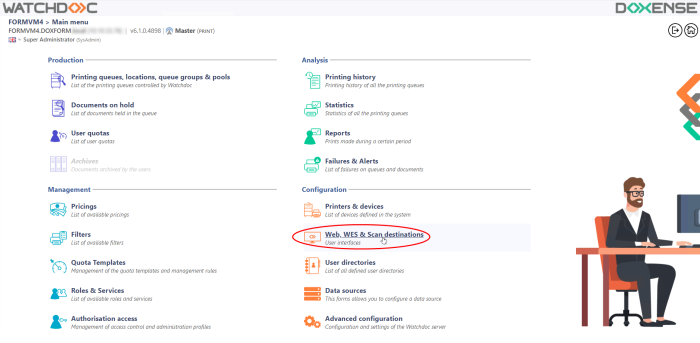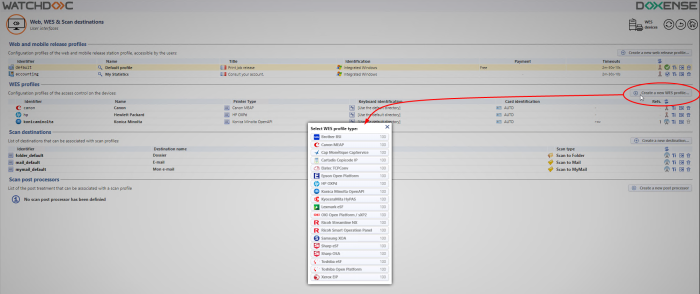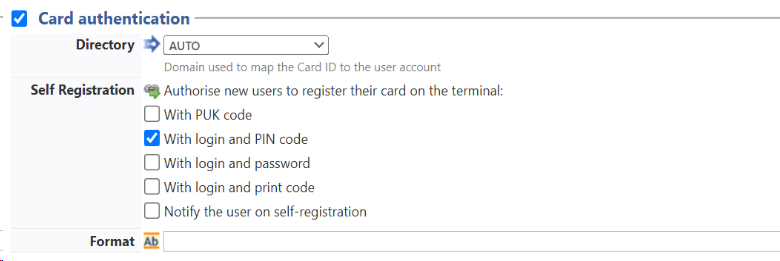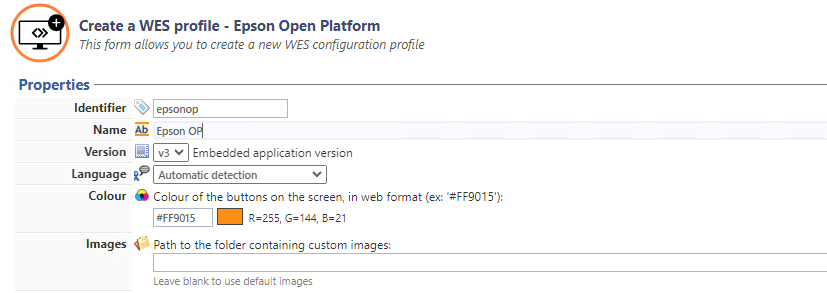Epson WES - Create and configure the WES profile
Create the WES profile
On a clean Watchdoc installation, a first WES profile is automatically created with default parameters at the end of the wizard procedure, but you can, at any time, edit existing profiles to modify them or create a new profile.
-
From the Main menu in the administration interface;
-
in the Configuration section, click on Web, WES & Scan destinations:

-
in the Web, WES & Scan Destinations - Client Interface Management interface, click on Create a new WES profile;
-
in the list, select the profile you want to create:

è you will access the Create a WES profile form, which contains a number of sections in which you can configure your WES.
A navigation bar helps you quickly access the desired section:
Configure the WES profile
Configure the Properties section
Use this section to state the main WES properties:
-
Identifier: Enter the single identifier for the WES profile. It can comprise letters, numbers and the '_' character with a maximum of 64 characters. This identifier is only displayed in the administration interfaces.
-
Name: enter the WES profile name. This explicit name is only displayed in the administration interfaces.
-
Global : in the case of a master/slave configuration, tick this box to replicate this profile on the slave servers.
-
Language: Select the WES display language configured from the list. If you select Automatic detection, the WES adopts the language it finds by default in the device configuration.
-
Version: select the version of WES. For v3, you can customise the interface by choosing the colour of the buttons and images to match your graphic identity:
-
Colour: enter the Hexadecimal color value corresponding to the WES button's colour. By default, the buttons are Watchdoc orange customized (#FF901). Once the value is entered, the colour is displayed in the field.
-
Images: if you want to customize the WES images, enter the folder path in which are recorded images you want to display instead of the default images (stored in C:\Program Files\Doxense\Watchdoc\Images\Embedded\Doxense\[Manufacturer_Name] by default).
-
Configure the Keyboard authentication section
You can activate Keyboard and/or Card authentications. For each option, you have to select the directory that Watchdoc will use for authentication requests.
Enable: tick the box (at the section level) to enable user authentication from a physical keyboard or the touch screen one, then set out how this authentication works:
-
Authentication mode: Specify how users are to authenticate themselves (entering a PIN code, a PUK code or an account and password).
-
PUK code authentication: codes are generated automatically by Watchdoc (Generation parameters are in the directory form);
-
Login and PIN Code: consisting of 4 or 5 digits, the user PIN code (1234, for example) is registered as an LDAP attribute or in a CSV file. It is associated to the user login (available with the Watchdoc 5.1 version).
-
Login and password: users will use their LDAP credentials. We do not recommend using this mode.
-
-
Directory: from the list, select the directory to query during keyboard authentication. If no directory is set, Watchdoc will query the default directory.

Configure the card authentication mode
Tick the box (at the section level) to enable user authentication from a card, then set out how this authentication works:
-
Directory: From the list, select the directory to query during badge authentication. If no directory is set, Watchdoc will query the default directory.
-
Self Registration: : If you enable enrollment1 from the WES, state how the user assigns their card to their account, using their PUK code or their account and password.
Disabled: the self-registration is not allowed: if the user is unknown, an error message is displayed;
-
with PUK code: the embedded solution will ask the user for its PUK code. If the PUK code is correct, Watchdoc stores the card number with the user's login in its database;
-
Login and password: the embedded solution will ask the user for his login and his password. If the data keyed in are correct, Watchdoc stores the card number with the user's login in its database.
-
Notify the user on self-registration: check this box to send a notification to the user when his badge has been enrolled.
-
-
Format: State, where necessary, how the character string for the badge number string is to be transformed. E.g. raw;cut(0,8);swap.

Configure the Anonymous connection section
Tick this section to activate the Anonymous connection in order to allow an unauthenticated user to access to the device by clicking a button.
It is possible to restrict the features that the anonymous user can access by applying a privilege policy to the queue, group, or server, and using the Anonymous User filter.
-
Button Label: Enter in this field the label displayed on the access button to the device features. By default, the text is Anonymous;
-
Redirection: From the list, choose the application to which the anonymous user must access after clicking the Anonymous:
-
Home: The user accesses to the device homepage;
-
Copy Application: The user accesses to the copy application;
-
Scan Application: The user accesses to the scan feature;
-
Fax application: The user accesses to the scan feature;

-
Configure the Pull print section
In this section, you can change options about the Watchdoc release application: sort order of the document, tariff information and optional pages.
You can bypass this application by enabling the automatic release mode. When the user is authenticated on the device, all its documents are released.
- Redirection: specify the behaviour of the WES when the user logs in, and in particular the redirection to a page other than the home page:
Waiting jobs: the WES displays the list of pending documents even if there are none.
Smart: the WES displays the default home interface if the user has no pending documents; on the other hand, if the user has pending documents, the WES displays the list of documents;
- Home: the WES displays the default home interface and does not redirect to any other interface.
-
Sort Order: Set the documents order on the device screen:
-
Reverse chronological: More recent documents will top the list;
-
Chronological: Older documents will top the list.
-
Release all documents at login: When the user logs on by swiping his card or typing his PIN code, Watchdoc releases all user documents on the device where he logs on.
-
-
Optional pages - Enable Page Zoom: Select this checkbox to enable the user to zoom in on jobs waiting to be printed (PCL 6 driver required).
- Optional pages: Tick the box o enable user adding more pages previews:
Enable Page Zoom: tick the box to enable the user to zoom in on jobs waiting to be printed (PCL 6 driver required).
Enable spool edition: User can modify the initial printing criteria;
Display print policy warning messages: tick the box to limit the number of decimal places displayed to the user in the tariff information.

Configure the Scan to section
The Scan (to me or to Folder) function for the Epson WES has been available since version 6.1.0.5011.
To configure this function, you need to have all the SMTP settings specific to Epson devices.
As a prerequisite, this function assumes that the authenticated user has an email address associated with their account, registered in an attribute of the LDAP directory.
-
Enable: tick the box if you wish to activate the function, then complete the following parameters:
-
Email: tick the box to create an account with the user's email address
-
Contact number*: if the Epson contact book is not used, leave the default value of 1;
-
Contact name: indicate the name associated with the proposed function (ScanToMe by default) in this field. This is the name that appears to the user in the list of applications on the print device screen.
-
-
To home folder: tick the box to authorise the scan and send to user folder function.
-
Contat number*: if the Epson contact book is not used, leave the default value 2;
-
Contact name: In this field, enter the name associated with the proposed function (ScanToFolder by default). This name will appear in the list of applications on the print device screen;
-
Nom de contact :In this field, enter the name associated with the proposed function (ScanToFolder by default). This name :
-
determines the name in the Epson print device's contact list;
-
appears in the list of applications on the Epson print device screen;
-
-
SMB account: enter the name of the account with write access to the folder;
-
SMB password: enter the password for the SMB account authorised to write to the folder ;
-
Sub-folder: by default, the scanned document is saved in the user's folder as defined in the ‘$HomeDirectory’ attribute of the directory (if LDAP). If you wish to change this, enter the name of the sub-folder dedicated to storing scanned documents here:

-
* If the device's contact book is already in use for other applications, go to these contacts to find out which number(s) are already in use and which are available for each of the ‘ScanToMe’ and/or ‘ScanToFolder’ functions:
Configure the Device section
This section is used to define the connection mode between the server and the print devices.
-
Server Address: The device needs to contact the Watchdoc server when the user tries to connect or wants to release his documents. You can specify the Watchdoc server address in three different ways: IP Address, DNS Address or Custom Address;
-
Mixed: the application uses SSL for sensitive data (PUK code, login/mdp, etc.) and not SSL for non-sensitive data;
-
No SSL: Select this item if the WES does not ever use SSL to communicate with the server.
-
-
Secure endpoint: specify the ports used for communication between the device and the Watchdoc server:
-
the custom access point (previously configured in the DSP section (see Configuring the Web Server):
-
the Watchdoc server's default port 5753 ;
-
-
Device security: indicate the device administrator login and password which Watchdoc needs to communicate with it during certain operations (automatic installation, requests, etc.).
Connection Mode: Enables you to enable or disable SSL for the communications between the MFP and the server:
-
OpenPlatform product keys:the product key is saved in a .csv file, provided by the Epson licence management service (see the operation described in the Installation prerequisites section). Enter the path to the .csv file in this field. If you do not have the key, click on the Epson web site link to access the form for obtaining the product key:

Validate the profile
1. Click on the button  to validate the WES profile configuration.
to validate the WES profile configuration.
→ Once validated, the WES profile can be applied to a print queue.
